Cancer screening has changed dramatically with the introduction of blood tests that can detect multiple types of cancer at once. The Galleri multi-cancer early detection test[1] can screen for more than 50 types of cancer with a single blood draw, including many cancers that currently have no recommended screening methods.
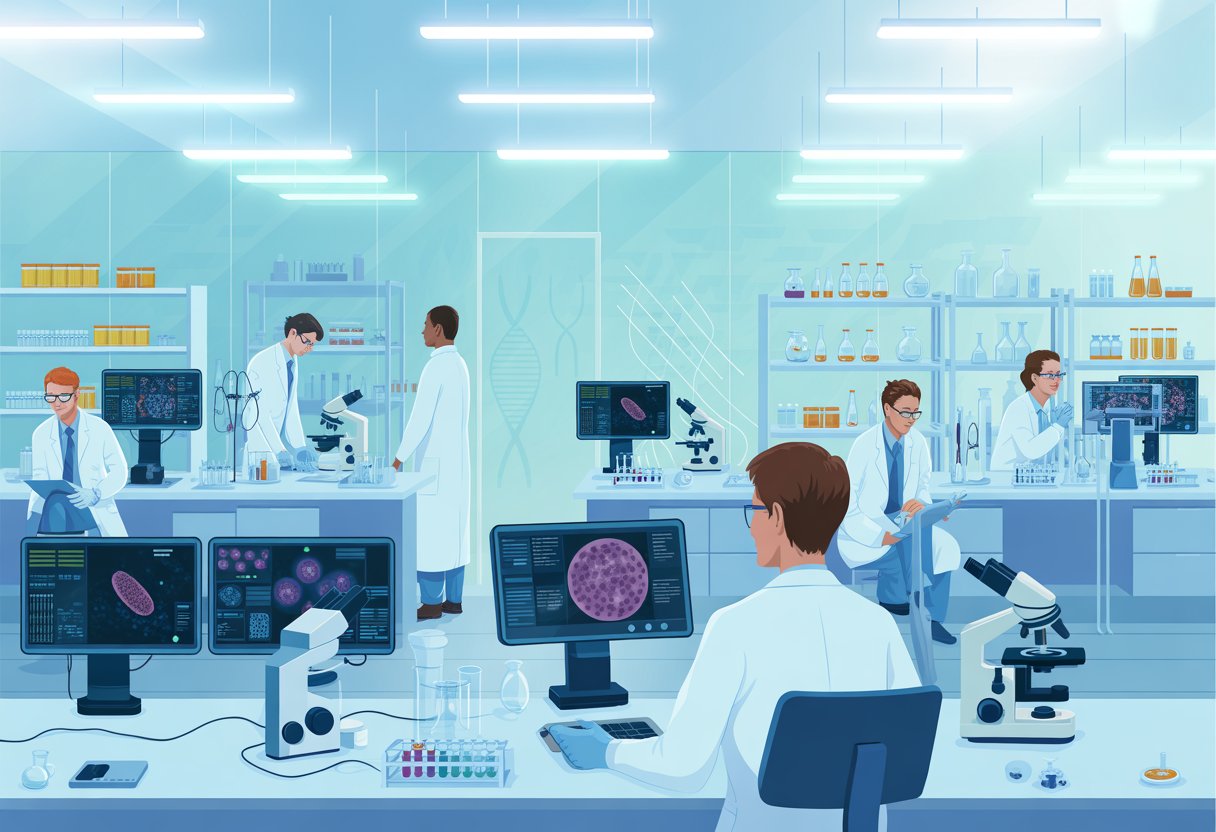
Traditional cancer screening focuses on one cancer at a time, like mammograms for breast cancer or colonoscopies for colorectal cancer. The Galleri test takes a different approach by looking for DNA signals that cancer cells release into the bloodstream. This means doctors can potentially catch cancers early when they are easier to treat.
The test is designed for adults who are 50 years old or older and have an elevated cancer risk. While the Galleri test does not detect all cancers[2] and can produce false positive and false negative results, it represents a major step forward in cancer detection technology. Understanding how this test works and who might benefit from it can help people make informed decisions about their cancer screening options.
Key Takeaways
- The Galleri test screens for over 50 cancer types with one blood test, detecting DNA signals released by cancer cells
- Adults aged 50 and older with elevated cancer risk are the recommended candidates for this screening method
- The test should complement, not replace, existing cancer screening tests recommended by healthcare providers
What Is the Galleri Test?

The Galleri test is a multi-cancer early detection blood test[3] that can identify more than 50 types of cancer from a single blood draw. This screening method analyzes DNA patterns in the bloodstream to detect cancer signals before symptoms appear.
Overview of Multi-Cancer Early Detection
Multi-cancer early detection represents a new approach to cancer screening. Instead of testing for one specific cancer type, these tests look for multiple cancers at once.
The Galleri test can detect more than 50 kinds of cancer[2] through a single blood sample. It works by finding cell-free DNA that cancer cells shed into the bloodstream as they die.
The test uses Next-Generation DNA Sequencing and machine learning technology. These tools analyze patterns in DNA methylation, which act like fingerprints for different cancer types.
Key capabilities include:
- Detection of over 50 cancer types
- Identification of cancer location with 90% accuracy
- Detection before symptoms develop
- Very low false-positive rate of 0.5%
The test finds 51.5% of all cancers it screens for. For the 12 deadliest cancers that cause two-thirds of cancer deaths, it detects 67% of cases.
Detection rates vary by cancer stage:
- Stage I: 40% detection rate
- Stage II: 67% detection rate
- Stage III: 80% detection rate
- Stage IV: 95% detection rate
How the Galleri Test Differs from Other Cancer Screening Tests
Traditional cancer screening tests focus on one specific cancer type. Mammograms check for breast cancer, colonoscopies look for colorectal cancer, and Pap tests screen for cervical cancer.
Currently, only five cancers have recommended regular screening tests in the United States. These include breast, cervical, colorectal, lung, and prostate cancers.
The Galleri test changes this approach completely. It screens for dozens of cancer types simultaneously through one blood test.
Major differences include:
| Traditional Screening | Galleri Test |
|---|---|
| One cancer per test | 50+ cancers per test |
| Requires multiple appointments | Single blood draw |
| Limited to common cancers | Includes rare cancers |
| 10-40% false-positive rate | 0.5% false-positive rate |
Most deadly cancers like pancreatic and ovarian cancer have no standard screening tests. These cancers often go undetected until Stage III or IV when symptoms appear.
The Galleri test can find those cancers at an earlier stage[2] before symptoms develop. This early detection could save lives for cancers that currently have poor survival rates.
The test supplements rather than replaces existing screening methods. Patients should continue getting recommended screenings like mammograms and colonoscopies.
Who Developed the Galleri Test
GRAIL developed the Galleri test as a healthcare technology company focused on early cancer detection. The company specializes in multi-cancer early detection research and technology.
Healthcare providers must register with GRAIL to order the test for their patients. The test is not currently FDA approved[2] but is available through healthcare providers.
GRAIL designed the test for adults over age 50 who may have higher cancer risk. The company recommends the test for people with family history of cancer or those who are immunocompromised.
The test costs $949 and insurance does not cover it[4]. GRAIL offers flexible payment options to make the test more accessible to patients.
The company continues research to improve the test’s accuracy and expand its capabilities. Future developments may allow blood tests to replace many traditional cancer screening methods.
How the Galleri Test Works
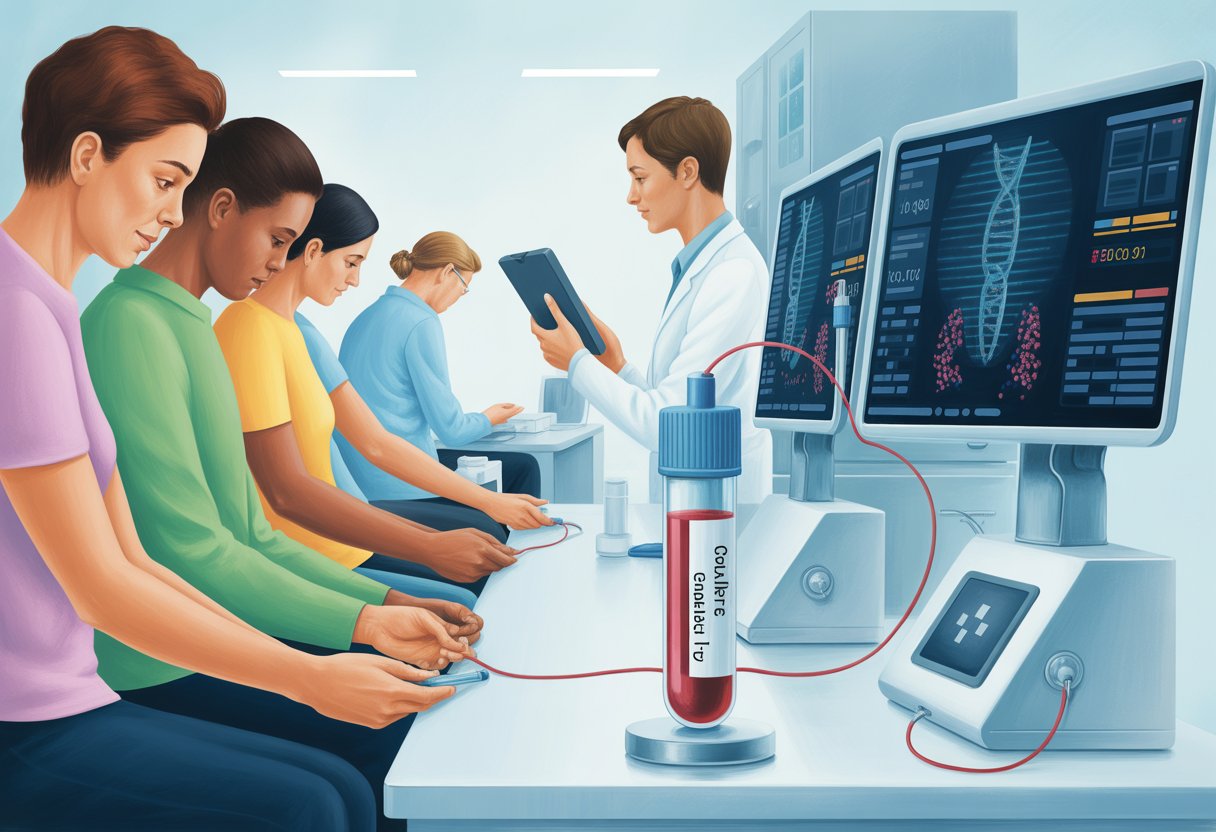
The Galleri test analyzes cell-free DNA fragments in blood to identify cancer signals through advanced technology and artificial intelligence. This blood-based screening method detects methylation patterns that indicate the presence of cancer and can predict where it started in the body.
Cell-Free DNA and Circulating DNA Explained
Cell-free DNA (cfDNA) consists of small DNA fragments that float freely in the bloodstream. These fragments come from cells throughout the body that naturally break down and release their genetic material.
Healthy cells and cancer cells both contribute to circulating DNA. However, cancer cells release DNA fragments with distinct characteristics that differ from normal cells.
When tumors grow, they shed more DNA into the blood than healthy tissue. This creates detectable changes in the overall cfDNA profile that can signal cancer presence.
The cfDNA fragments are very small, typically 150-200 base pairs long. They have a short lifespan in blood, usually cleared within hours by the liver and kidneys.
Key cfDNA Sources:
- Normal cell turnover
- Cancer cell death
- Immune system activity
- Tissue injury or inflammation
Technology and Methodology of the Test
The Galleri test uses artificial intelligence analysis of cell-free DNA[5] to identify cancer-specific patterns. The process begins with a simple blood draw that requires no special preparation.
Laboratory technicians extract cfDNA from the blood sample using specialized equipment. The DNA undergoes targeted methylation analysis, which examines chemical modifications on the DNA strands.
Methylation patterns serve as fingerprints that can distinguish cancer DNA from normal DNA. Different cancer types produce unique methylation signatures that help identify the tissue of origin.
Test Process Steps:
- Blood collection (single tube)
- cfDNA extraction
- Methylation analysis
- AI pattern recognition
- Cancer signal classification
The artificial intelligence system compares detected patterns against a database of known cancer signatures. This comparison determines both cancer presence and likely location.
Understanding Cancer Signal Detection
Cancer signals represent specific DNA methylation patterns that indicate tumor presence in the body. The Galleri test can detect more than 50 kinds of cancer[2] through these molecular signatures.
Each cancer type creates distinct methylation changes that act like biological barcodes. The test identifies these unique patterns and matches them to specific tissue origins with high accuracy.
Cancer signal strength typically increases with tumor size and stage. Early-stage cancers produce weaker signals that are harder to detect than advanced cancers.
The test achieves different sensitivity levels depending on cancer stage and type. Detection rates improve significantly as cancers progress from stage I to stage IV.
Cancer Signal Characteristics:
- Specificity: 99.5% accuracy in ruling out cancer
- Tissue prediction: 88.7% accuracy for origin location
- Stage correlation: Higher detection in advanced stages
- Multi-cancer capability: Over 50 different cancer types
False signals can occur due to inflammation, infections, or other medical conditions that affect DNA methylation patterns.
Cancers Detected by the Galleri Test
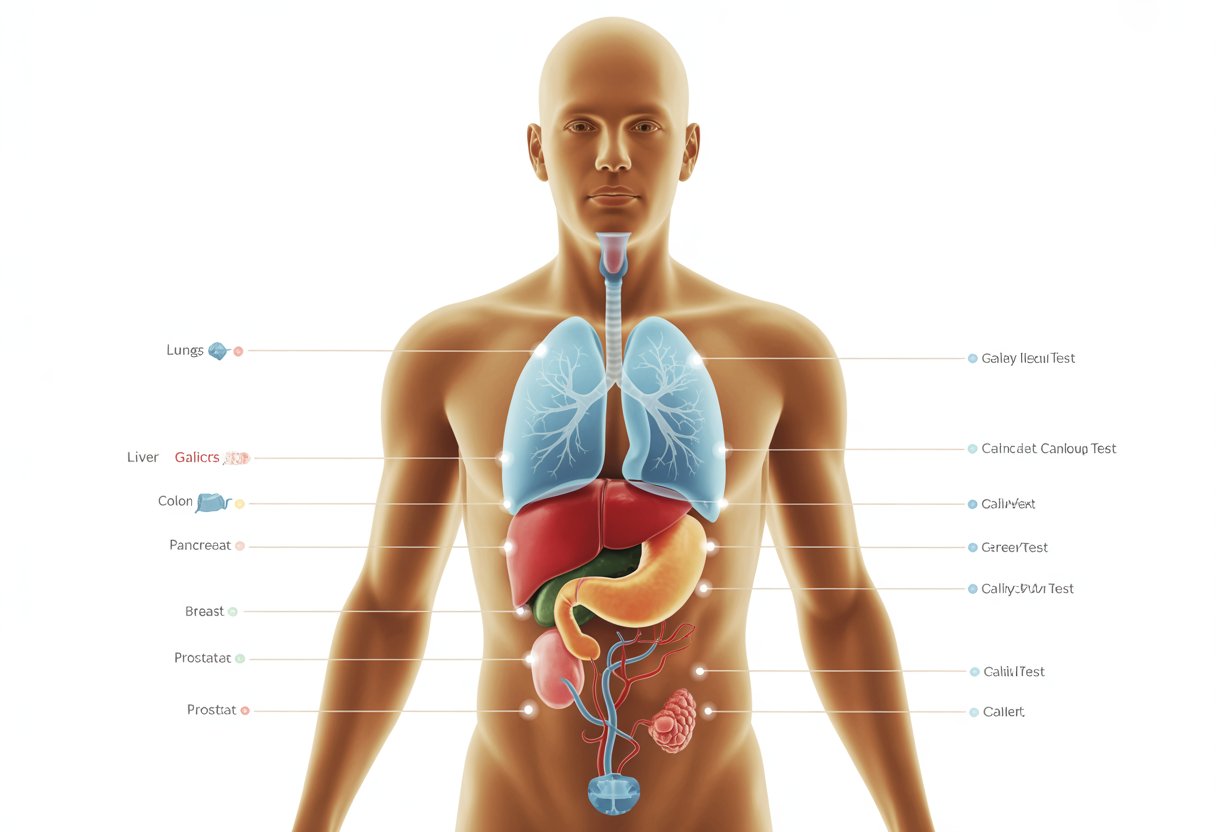
The Galleri test can detect more than 50 kinds of cancer[2] through a single blood draw. This multi-cancer early detection test shows varying accuracy levels depending on cancer type and stage, with particular value for cancers that lack standard screening methods.
Types of Cancers Screened
The Galleri multi-cancer early detection test screens for over 50 different cancer types in a single blood sample. The test focuses on 12 specific cancer types that account for about two-thirds of annual cancer deaths in the United States.
Key Cancer Types Include:
- Lung cancer
- Breast cancer
- Colorectal cancer
- Pancreatic cancer
- Ovarian cancer
- Liver cancer
- Stomach cancer
- Esophageal cancer
The test also detects many other cancer types beyond these primary ones. It uses artificial intelligence to analyze cell-free DNA patterns in blood samples.
The multi-cancer early detection approach allows doctors to screen for multiple cancers at once. This is different from traditional screening that focuses on one cancer type at a time.
Detection for Hard-to-Screen Cancers
Galleri can identify cancers for which no established screening method exists[6], including pancreatic, ovarian, and liver cancers. These cancers often go undetected until late stages because they lack effective screening options.
About 70% of cancer deaths in the United States come from cancers without standard population-based screening programs. The Galleri test addresses this gap by detecting signals from these hard-to-screen cancers.
Cancers Without Standard Screening:
- Pancreatic cancer
- Ovarian cancer
- Liver cancer
- Kidney cancer
- Brain tumors
The test correctly identifies the tissue of origin in 88.7% of true-positive cases. This helps doctors know where to look for the cancer when follow-up testing is needed.
Accuracy and Limitations by Cancer Type
The Galleri test shows 99.5% specificity[5] but sensitivity varies significantly by cancer stage and type. Overall sensitivity reaches 51.5% across all cancer types.
Sensitivity by Stage:
- Stage I: 16.8%
- Stage II: 40.4%
- Stage III: 77.0%
- Stage IV: 90.1%
Early-stage cancers are much harder to detect than advanced cancers. For the 12 most deadly cancer types, sensitivity improves to 67.6% in stages I through III.
The test performs better for some cancers than others. Rectal cancer and other colorectal cancers show different detection rates depending on their specific characteristics.
False-positive results occur in about 0.5% of cases. When cancer signals are detected, about 45% represent actual cancer after diagnostic follow-up testing.
The test cannot replace standard cancer screening methods like mammograms or colonoscopies. It works best when used alongside existing screening programs for cancer diagnosis.
Who Should Consider the Galleri Test?
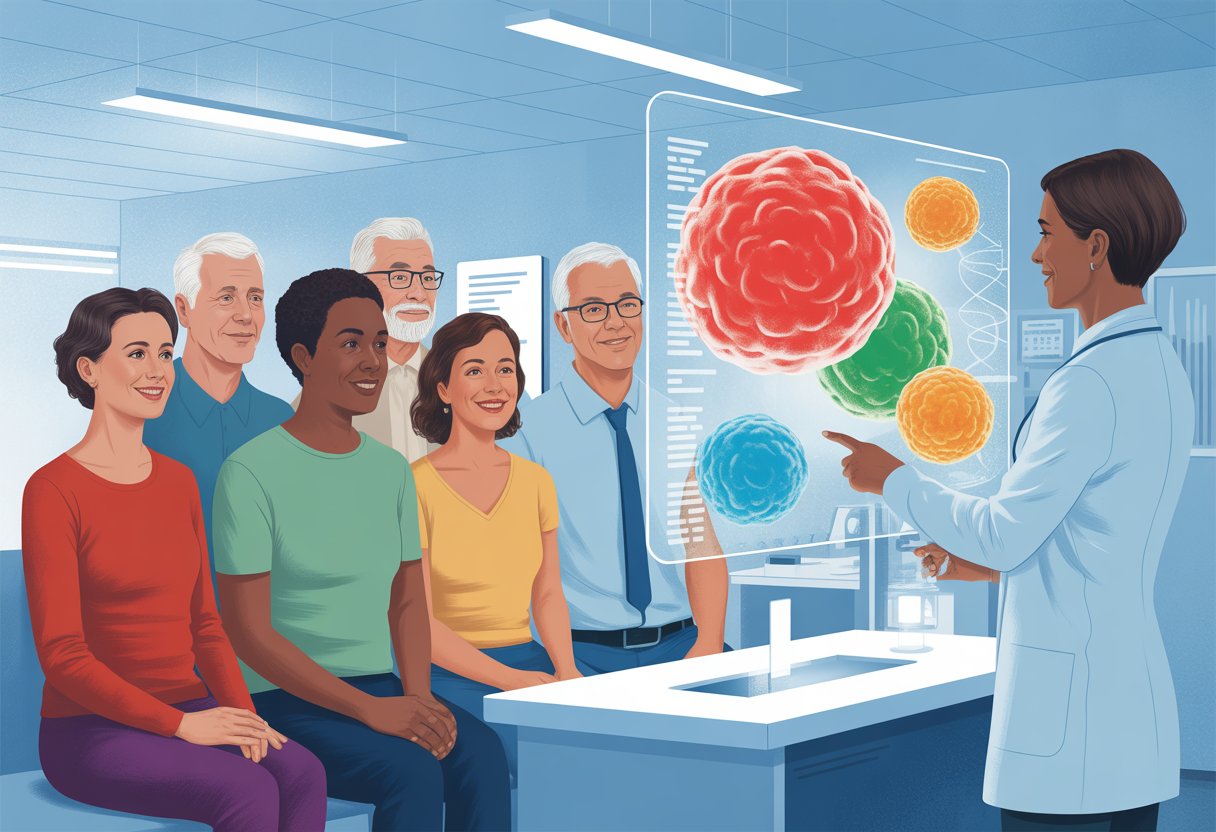
The Galleri test is designed for adults aged 50 and older[5] who want additional cancer screening beyond standard methods. It works best as a supplement to existing cancer screenings rather than a replacement.
Recommended Candidates and Age Groups
Adults aged 50 and older represent the primary target group for Galleri testing. This age threshold aligns with when cancer risk naturally increases in the general population.
The test performs better in detecting later-stage cancers. Stage III cancers show detection rates of 77%, while Stage IV cancers reach 90.1% detection rates.
People living in rural areas may find particular value in this blood-based approach. The simple blood draw eliminates travel barriers that often prevent access to specialized screening facilities.
Individuals with family histories of cancer may consider this test for broader screening coverage. The Galleri test can screen for more than 50 cancer types[2], including many that lack standard screening options.
Those seeking comprehensive cancer surveillance beyond traditional methods represent ideal candidates. Standard screenings only cover a few cancer types, while this test expands detection possibilities significantly.
Eligibility Criteria and Health Factors
The test is specifically intended for asymptomatic adults without current cancer diagnoses. People experiencing cancer symptoms should pursue diagnostic testing through their healthcare providers instead.
Cost considerations play a major role in eligibility. The test costs $949 and lacks general insurance coverage[5], making it primarily accessible to those who can afford out-of-pocket expenses.
Some employers offer Galleri testing as an employee benefit. Workers should check with their benefits departments about potential coverage options.
The test should complement existing cancer screenings[7] like mammograms, colonoscopies, and Pap smears rather than replace them. Patients must maintain their regular screening schedules.
People comfortable with potential false-positive results make better candidates. The test requires follow-up diagnostic procedures when positive signals appear, which can create anxiety and additional medical expenses.
Galleri Test Results and Follow-Up Steps
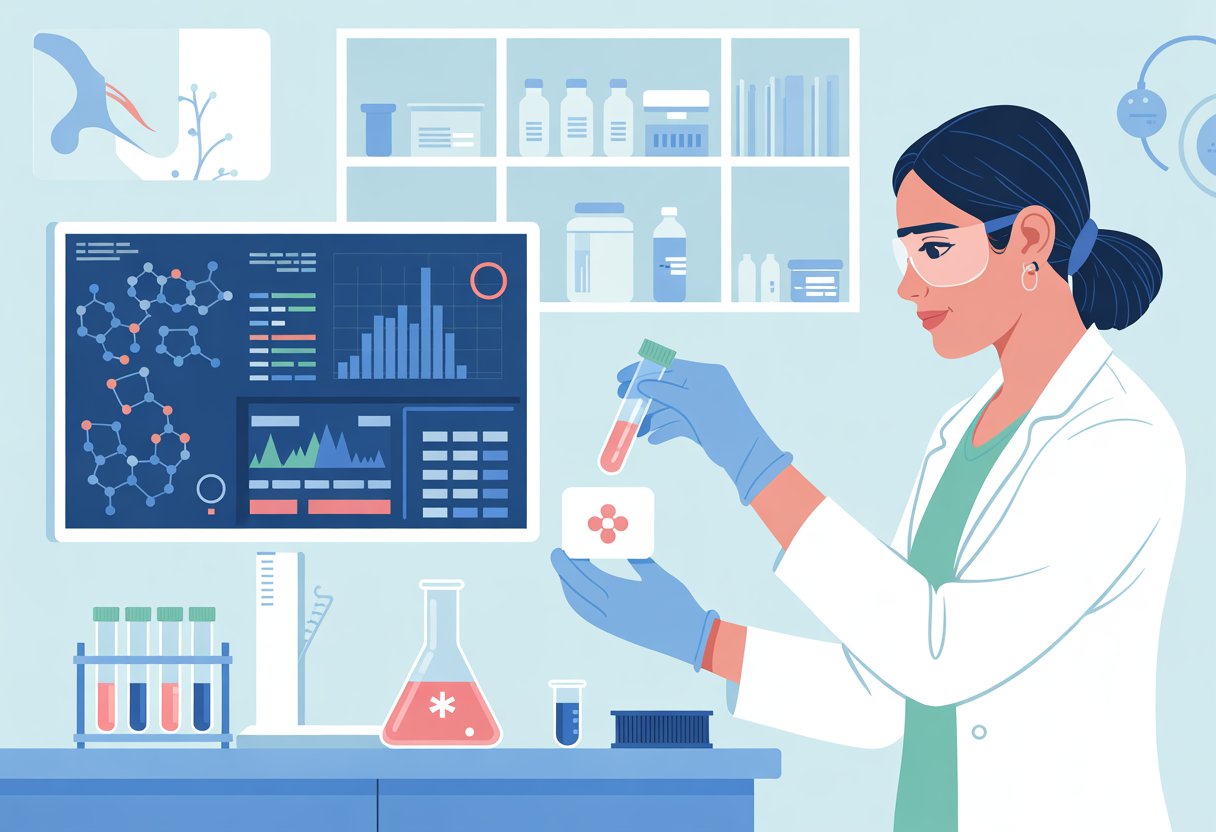
The Galleri test provides two possible outcomes that determine the next course of action. Understanding your Galleri test results[8] requires knowing what each result means and the specific steps healthcare providers recommend for follow-up care.
Understanding Positive and Negative Results
The Galleri cancer screening test delivers one of two clear results. A “No Cancer Signal Detected” result occurs in nearly 99% of people who use the Galleri test[8].
This negative result means the test did not find DNA fragments associated with cancer in the blood sample. However, it does not completely rule out cancer.
A “Cancer Signal Detected” result appears in approximately 1% of people ages 50-79. This positive result indicates the test found DNA fragments that may be associated with cancer.
The test also provides a Cancer Signal Origin (CSO) prediction[9]. This tells doctors which tissue type or organ might be associated with the cancer signals.
Key limitations apply to both results:
- False positive and false negative results can occur
- The test cannot detect all cancer types
- Some cancers shed little DNA into the bloodstream
- Brain, skin, and early-stage breast and prostate cancers are harder to detect
Next Steps After a Cancer Signal is Detected
A positive result requires immediate diagnostic testing to confirm whether cancer is present. The cancer screening test does not diagnose cancer by itself.
Healthcare providers typically order additional tests based on the Cancer Signal Origin prediction. These may include imaging scans, lab work, or other diagnostic procedures.
Around 6 out of 10 people with a Cancer Signal Detected result receive a confirmed cancer diagnosis[8] after diagnostic testing. The remaining 4 out of 10 people do not have cancer confirmed.
Common follow-up tests include:
- CT scans or MRI imaging
- Blood work and tumor markers
- Tissue biopsies
- Organ-specific examinations
The cost of diagnostic testing is separate from the Galleri test cost. Patients should contact their insurance providers about coverage for follow-up testing.
Role of Healthcare Providers in Interpretation
Healthcare providers play a critical role in interpreting Galleri test results. They consider the results alongside medical history, clinical signs, and symptoms.
Doctors help patients understand that negative results do not eliminate the need for routine cancer screening. The Galleri test should be used in addition to healthcare provider recommended screening tests[8].
For positive results, providers coordinate the diagnostic workup. They determine which tests to order based on the Cancer Signal Origin prediction and the patient’s specific situation.
Healthcare providers also help patients understand the timeline for cancer detection results. Test results become available approximately two weeks after the blood sample reaches the laboratory.
Provider responsibilities include:
- Ordering appropriate follow-up tests
- Coordinating care with specialists
- Explaining test limitations and accuracy
- Scheduling regular retesting as needed
Comparing Galleri to Traditional Cancer Screening Methods
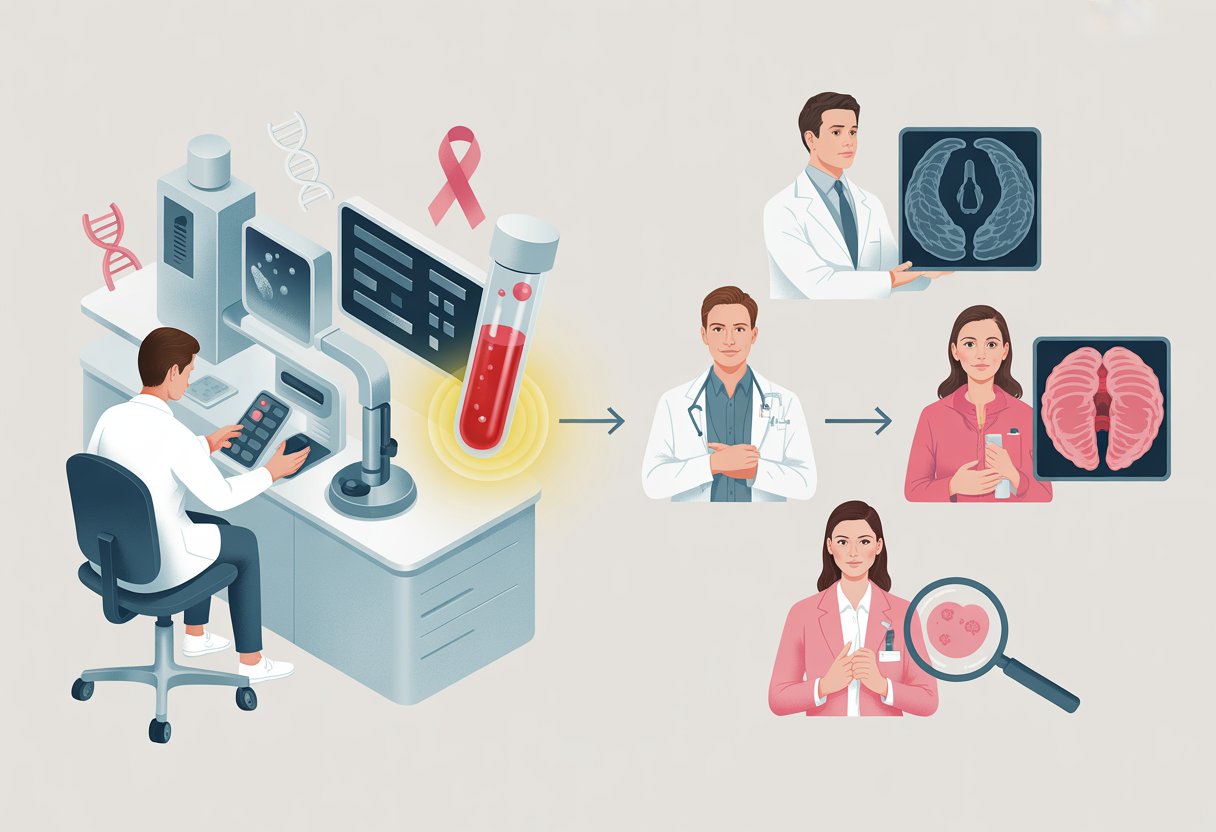
The Galleri test works differently than mammograms and colonoscopies by detecting cancer signals in blood rather than imaging specific organs. This blood test is designed to work alongside existing screening methods rather than replace them.
Galleri Versus Mammograms and Colonoscopies
Traditional screening methods like mammograms and colonoscopies focus on specific organs and have proven track records. Mammograms can detect breast cancer early with high accuracy rates. Colonoscopies can find colon cancer and remove precancerous polyps during the procedure.
The Galleri test detects more than 50 cancer types[5] through a single blood draw. However, its sensitivity varies by cancer stage, with only 16.8% sensitivity for stage I cancers compared to 90.1% for stage IV cancers.
Key Differences:
- Scope: Galleri screens multiple cancers; traditional methods target specific organs
- Method: Blood test versus imaging or physical examination
- Convenience: Single blood draw versus separate appointments for different screenings
- Cost: Galleri costs $949 and lacks insurance coverage; traditional screenings are often covered
Traditional methods remain more reliable for their specific cancer types. Mammograms and colonoscopies can detect cancers that Galleri might miss in early stages.
Integration with Routine Cancer Screening Tests
The Galleri test should complement established screening tests[10] recommended by healthcare providers. It cannot replace routine cancer screening methods due to its lower sensitivity in early-stage cancers.
Doctors may recommend Galleri for patients who want broader cancer screening coverage. The test can identify cancers without established screening methods[6], including pancreatic, ovarian, and liver cancers.
Integration Strategy:
- Continue regular mammograms, colonoscopies, and other recommended screenings
- Add Galleri as supplemental testing for broader coverage
- Follow up positive Galleri results with standard diagnostic procedures
Studies suggest that adding Galleri to traditional screenings can nearly double cancer detection rates. However, patients still need their routine cancer screening tests for optimal protection.
The combination approach maximizes early detection while maintaining the proven benefits of established screening methods.
Benefits, Limitations, and Considerations

The Galleri test offers expanded cancer detection capabilities[6] but comes with important limitations including variable detection rates and insurance coverage challenges. Understanding both the advantages and constraints helps patients make informed decisions about this emerging screening technology.
Advantages of Multi-Cancer Blood Testing
The Galleri test can detect more than 50 types of cancer[2] through a single blood draw. This represents a major advance over traditional screenings that only test for specific cancers.
Key Benefits:
- Identifies cancers without established screening methods
- Detects pancreatic, ovarian, and liver cancers
- Can determine where cancer originated in the body
- Works before symptoms appear
The test nearly doubles cancer detection rates[6] when added to standard screenings. It analyzes cell-free DNA to identify abnormal patterns that act like cancer fingerprints.
The false-positive rate is about 0.5%[6], which is considered low for cancer screening tests. This means fewer unnecessary follow-up tests compared to many other screening methods.
Potential Risks and False Results
Detection accuracy varies significantly by cancer stage. Early-stage cancers show detection rates of only 17% for Stage I[6] and 40-50% for Stage II cancers.
Detection Rates by Stage:
- Stage I: 17%
- Stage II: 40-50%
- Stage IV: 90%
Some positive results may not indicate actual cancer[6]. Follow-up imaging and additional tests become necessary when the test shows positive results.
Patients may experience anxiety during the follow-up process. The company offers a repeat test at no cost after six months if initial results are unclear.
Insurance Coverage, Cost, and Accessibility
The test costs $949 and most insurance providers do not cover it[4]. This creates a significant barrier for many patients seeking multi-cancer screening.
Cost Considerations:
- List price: $949
- Insurance coverage: Limited
- Payment plans: Available through some providers
The test is recommended for adults 50 years or older[5] who are asymptomatic. Healthcare providers must operate under Clinical Laboratory Improvement Amendments regulations when offering the test.
Grail, the company behind Galleri, continues working with insurance companies to expand coverage options. Flexible payment options are available[4] to increase accessibility for patients.
Current Research, Trials, and Future Outlook
The NHS-Galleri trial[11] represents one of the largest studies examining multi-cancer detection effectiveness. This research involves thousands of participants across the United Kingdom.
The test’s effectiveness is still being studied[12], and more research is needed to understand its full potential. Scientists are working to improve detection rates for early-stage cancers.
Future developments may include better accuracy for Stage I and II cancers. Researchers are also studying how the test performs across different populations and age groups.
The technology uses artificial intelligence to analyze DNA patterns. Ongoing improvements to these algorithms could enhance both sensitivity and specificity in future versions of the test.
Frequently Asked Questions
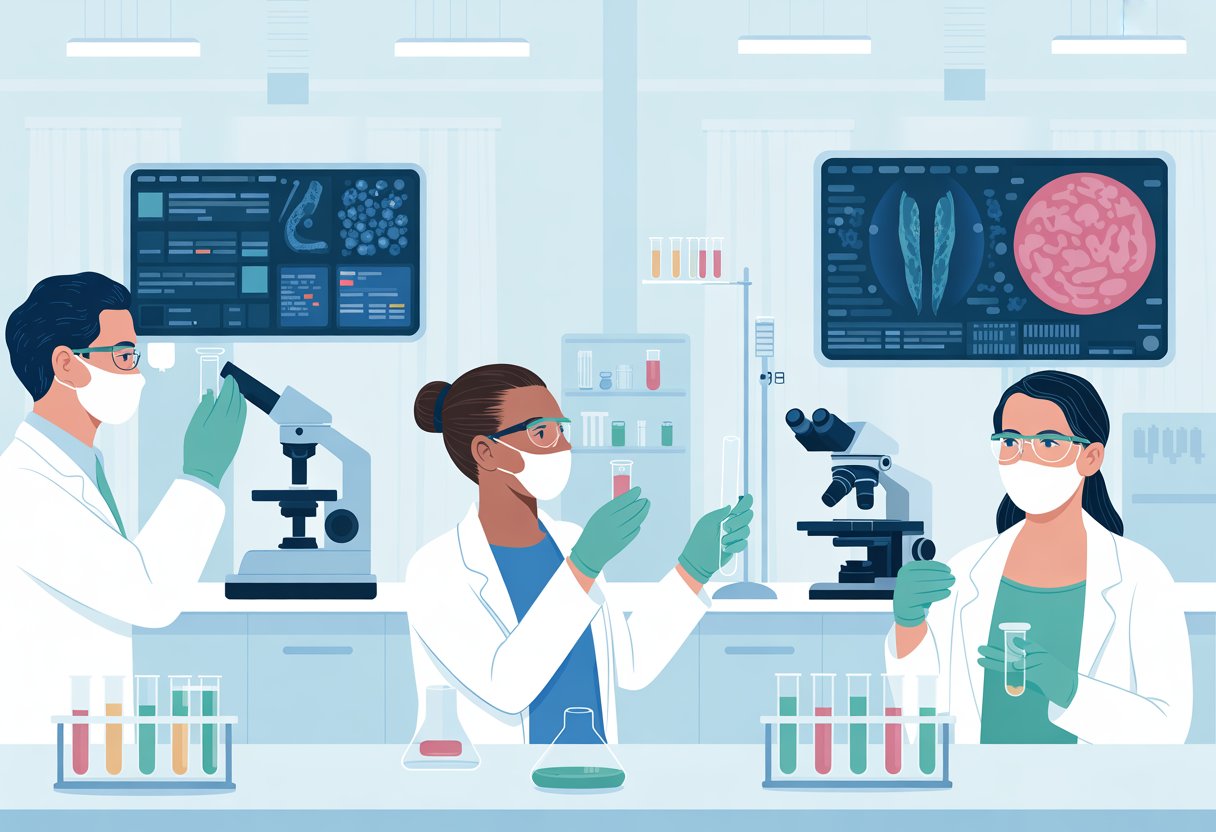
The Galleri test can detect more than 50 types of cancer[2] through a simple blood draw. The test costs $949 and shows 99% accuracy in avoiding false positives for people without cancer.
What types of cancer can be detected by the multi-cancer early detection blood test?
The Galleri test can screen for more than 50 types of cancer[13] in a single blood test. These include many aggressive cancers that cause about two-thirds of cancer deaths.
The test can find cancers that have no other screening tests available. It looks for fast-spreading cancers before symptoms appear.
Some cancers are harder to detect through blood tests. Brain, skin, and early breast and prostate cancers may not shed enough DNA into the bloodstream for detection.
How accurate is the Galleri test in identifying various cancers?
Nearly 99% of people ages 50-79 receive a “No Cancer Signal Detected” result[13]. About 1% get a “Cancer Signal Detected” result.
When the test shows a cancer signal, about 62% of people actually have cancer after follow-up testing. The false positive rate is 0.4% for people without cancer.
The test predicts the cancer’s location with 93.4% accuracy[13]. This helps doctors know where to look for the cancer.
False positive and false negative results can happen. The test does not detect all cancers.
What is the cost of the multi-cancer early detection test?
The Galleri test costs $949[13] as the list price. The blood draw is included in this price when scheduled with GRAIL lab partners.
Most health insurance plans do not cover the test yet. TRICARE now covers it for eligible beneficiaries with prior approval needed.
People may use pretax dollars from flexible spending accounts or health savings accounts to pay. They should check with their plan administrator first.
Discounts may be available through healthcare providers, employers, or life insurance companies. Payment plans are also offered.
How does the early detection cancer blood test work?
Cancers growing in the body shed DNA into the bloodstream[13]. These DNA pieces act like a unique fingerprint for cancer.
The test looks for specific DNA patterns called methylation patterns. These patterns are often linked to cancer cells.
The test uses artificial intelligence to analyze the blood sample. It can predict where in the body the cancer signal comes from.
The test identifies active cancer cells, not future genetic risk. It is a point-in-time measurement of what is happening now.
Where can I get the Galleri blood test?
The test is available by prescription only in the United States[13]. People can request it through their healthcare provider or through an independent telemedicine provider online.
Blood draws can be done at partner labs, at home, or at a doctor’s office. Trained technicians perform the blood collection.
People need to be 50 years or older for the test to be recommended. It is not recommended for pregnant women, people 21 or younger, or those getting active cancer treatment.
What should I expect during and after taking the Galleri cancer detection test?
The blood draw takes about 1.5 tablespoons of blood from a vein[13] in the arm. No fasting is required before the test.
Results typically come back within 2 weeks[13] after the lab receives the sample. Some results may take up to 4 weeks.
People receive results by email if they provide an email address. Results are automatically shared with the doctor who ordered the test.
A “Cancer Signal Detected” result is not a cancer diagnosis. It requires follow-up testing like imaging or lab work to confirm cancer.
People with “No Cancer Signal Detected” results should continue regular cancer screenings. The test can be taken annually as part of wellness visits.
References
- Blood Test for Cancer Screening. https://www.galleri.com/ Accessed November 7, 2025
- The Galleri Test for Cancer Screening. https://health.clevelandclinic.org/the-galleri-test Accessed November 7, 2025
- What is an Early Cancer Detection Test?. https://www.galleri.com/what-is-galleri/multi-cancer-early-detection Accessed November 7, 2025
- Galleri® Multi-Cancer Early Detection Test: Comprehensive Overview – Revolution Health & Wellness. https://revolutionhealth.org/blogs/news/galleri-multi-cancer-early-detection-overview Accessed November 7, 2025
- Galleri Test for the Detection of Cancer. https://www.aafp.org/pubs/afp/issues/2022/1000/diagnostic-tests-galleri-test-cancer.html Accessed November 7, 2025
- What Is the Galleri® Multi-Cancer Early Detection Test?. https://www.bouldermedicalcenter.com/galleri-multi-cancer-early-detection-test/ Accessed November 7, 2025
- test should complement existing cancer screenings. https://ce.mayo.edu/sites/default/files/media/2023-09/Galleri%20HCP%20Detail%20Aid%20.pdf Accessed November 7, 2025
- Understanding Your Galleri Test Results. https://www.galleri.com/patient/understanding-your-results Accessed November 7, 2025
- Real-world data and clinical experience from over 100,000 multi-cancer early detection tests. https://pubmed.ncbi.nlm.nih.gov/41173830/ Accessed November 7, 2025
- Galleri Test Accuracy: How Reliable Is the Multi-Cancer Blood Test?. https://www.everlywell.com/blog/cancer-screening/galleri-test-accuracy/ Accessed November 7, 2025
- Embracing cancer complexity: Hallmarks of systemic disease. https://pubmed.ncbi.nlm.nih.gov/38552609/ Accessed November 7, 2025
- What is the effectiveness of the Galleri (multi-cancer early detection) blood test for cancer screening?. https://www.droracle.ai/articles/163767/how-effective-is-the-galleri-blood-test-gor-cancer Accessed November 7, 2025
- Frequently Asked Questions (FAQs) for Patients. https://www.galleri.com/patient/faqs Accessed November 7, 2025
